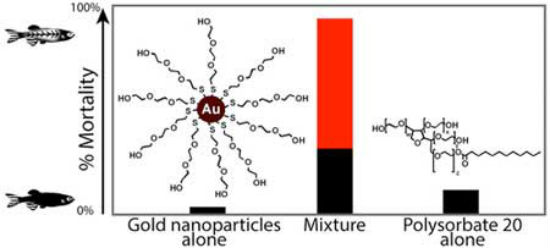|
NOVIDADES
A new study finds reason for caution - a clear emergence of toxicity - in nanomaterial product formulations, but it also provides an early testing technique that could help the industry continue to move forward. In a surprise discovery, University of Oregon chemists and Oregon State University toxicologists found that biocompatible gold nanoparticles and widely used surfactants - each previously considered safe as individual components - become toxic to zebrafish embryos as they combine in a synergistic way. The synergistic, or multiplicative effect, was discovered when using a new delivery system while testing nanomaterials, the four-member research team noted in a paper in ACS Nano ("Synergistic Toxicity Produced by Mixtures of Biocompatible Gold Nanoparticles and Widely Used Surfactants").  The team investigated the influence of surfactants on nanoparticle biocompatibility by studying mixtures of ligand-stabilized gold nanoparticles and Polysorbate 20 in embryonic zebrafish. These mixtures produced synergistic toxicity at concentrations where the individual components were benign. © ACS
"Our new study gives us a wakeup call," he said. "This isn't the first time that people have seen mixture toxicity, but it does remind us that two safe things mixed together doesn't mean that the mixture is safe." It is not clear, he said, if toxicity in zebrafish suggests a threat to human health. In nanotechnology's infancy, toxicologists hand delivered nanoparticles to zebrafish using pipettes. Hutchison and OSU co-author Robert Tanguay had previously had found that inorganic nanoparticles and surfactants, individually, were not toxic to zebrafish. However, a switch to automation - using inkjet-printer-like devices to rapidly inject materials employing small amounts of surfactant to control the size of the delivered droplets - brought unforeseen effects. The new study found an 88 percent mortality rate of zebrafish embryos exposed to gold nanoparticles mixed with polysorbate 20, whereas pipette delivery of the nanoparticles alone resulted in just 3 percent toxicity. Polysorbates are surfactants and emulsifiers commonly used in laundry detergent, suntan lotions, cosmetics and ice cream. The team also found synergistic toxicity using two other common surfactants, polysorbate 80 and sodium dodecyl sulfate. In the project, the researchers re-examined the toxicity of nanoparticles that had been studied as part of the Safer Nanomaterials and Nanomanufacturing Initiative, which was funded by the Air Force Research Laboratory. The National Science Foundation and National Institutes of Health supported the recent work. The cause of the synergistic toxicity was discovered when materials were analyzed with diffusion-ordered NMR spectroscopy, an adaptation of nuclear magnetic resonance that reveals how particles move, or diffuse, in solution. As increasing amounts of surfactants were added, the researchers observed that the particles diffused more slowly because the surfactant assembles on the outside of the gold nanoparticles, leading to both increased uptake and toxicity, driven by surface structure, in the zebrafish. "Our NMR method allowed us to state that this synergistic toxicity is really related to the interaction of these two benign materials and that it generates something that is more toxic," Hutchison said. The rapid-screening approach used in the research, he said, could serve as an early screening method. It would allow for adjustments in formulations or the redesign of individual ingredients before large investments have been made, to assure that products are safe, Hutchison said. "Zebrafish have proven to be a powerful high-throughput screening laboratory model that helps us to rapidly discover if chemical mixtures are hazardous," Tanguay said. "It's not a human, but the biological similarities between human and zebrafish are remarkably high, so findings in zebrafish often predict human hazards." Hutchison and Tanguay are internationally known for pioneering the use of green chemistry, also known as sustainable chemistry, in designing nanoparticles. The technique harnesses molecular design principles to produce safer chemicals, reduce toxicity and minimize waste. Aurora L. Ginzburg, a UO doctoral student working on the synthesis of gold nanoparticles for biomedical uses, led the analysis efforts using equipment in the UO's Center for Advanced Materials Characterization in Oregon, known as CAMCOR. Lisa Truong, deputy director of OSU's Sinnhuber Aquatic Research Laboratory, also was a co-author. Her focus is utilizing the developmental zebrafish model to assess the safety of chemicals and products in commerce. University of Oregon. Posted: Jun 29, 2018. Assuntos Conexos: |
|||||||||||||||||||||||||